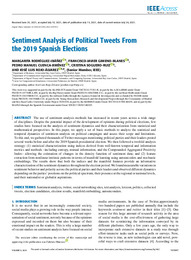Por favor, use este identificador para citar o enlazar este ítem:
https://hdl.handle.net/11000/30610Registro completo de metadatos
| Campo DC | Valor | Lengua/Idioma |
|---|---|---|
| dc.contributor.author | Rodríguez Ibáñez, Margarita | - |
| dc.contributor.author | Gimeno Blanes, Francisco Javier | - |
| dc.contributor.author | Cuenca Jiménez, Pedro Manuel | - |
| dc.contributor.author | Soguero-Ruiz, Cristina | - |
| dc.contributor.author | Rojo-Álvarez, José Luis | - |
| dc.contributor.other | Departamentos de la UMH::Ingeniería de Comunicaciones | es_ES |
| dc.date.accessioned | 2024-01-24T11:29:30Z | - |
| dc.date.available | 2024-01-24T11:29:30Z | - |
| dc.date.created | 2021-07 | - |
| dc.identifier.citation | IEEE Access Volume: 9 (2021) | es_ES |
| dc.identifier.issn | 2169-3536 | - |
| dc.identifier.uri | https://hdl.handle.net/11000/30610 | - |
| dc.description.abstract | The use of sentiment analysis methods has increased in recent years across a wide range of disciplines. Despite the potential impact of the development of opinions during political elections, few studies have focused on the analysis of sentiment dynamics and their characterization from statistical and mathematical perspectives. In this paper, we apply a set of basic methods to analyze the statistical and temporal dynamics of sentiment analysis on political campaigns and assess their scope and limitations. To this end, we gathered thousands of Twitter messages mentioning political parties and their leaders posted several weeks before and after the 2019 Spanish presidential election. We then followed a twofold analysis strategy: (1) statistical characterization using indices derived from well-known temporal and information metrics and methods –including entropy, mutual information, and the Compounded Aggregated Positivity Index– allowing the estimation of changes in the density function of sentiment data; and (2) feature extraction from nonlinear intrinsic patterns in terms of manifold learning using autoencoders and stochastic embeddings. The results show that both the indices and the manifold features provide an informative characterization of the sentiment dynamics throughout the election period. We found measurable variations in sentiment behavior and polarity across the political parties and their leaders and observed different dynamics depending on the parties’ positions on the political spectrum, their presence at the regional or national levels, and their nationalist or globalist aspirations. | es_ES |
| dc.format | application/pdf | es_ES |
| dc.format.extent | 16 | es_ES |
| dc.language.iso | eng | es_ES |
| dc.publisher | Institute of Electrical and Electronics Engineers | es_ES |
| dc.rights | info:eu-repo/semantics/openAccess | es_ES |
| dc.rights | Attribution-NonCommercial-NoDerivatives 4.0 Internacional | * |
| dc.rights.uri | http://creativecommons.org/licenses/by-nc-nd/4.0/ | * |
| dc.subject | Sentiment analysis | es_ES |
| dc.subject | es_ES | |
| dc.subject | social networking sites | es_ES |
| dc.subject | text analysis | es_ES |
| dc.subject | lexicon | es_ES |
| dc.subject | politics | es_ES |
| dc.subject | collected tweets | es_ES |
| dc.subject | election candidates | es_ES |
| dc.subject | election results | es_ES |
| dc.subject | manifold embedding | es_ES |
| dc.subject | autoenconders | es_ES |
| dc.subject.other | CDU::6 - Ciencias aplicadas::62 - Ingeniería. Tecnología | es_ES |
| dc.title | Sentiment Analysis of Political Tweets From the 2019 Spanish Elections | es_ES |
| dc.type | info:eu-repo/semantics/article | es_ES |
| dc.relation.publisherversion | https://doi.org/10.1109/ACCESS.2021.3097492 | es_ES |

Ver/Abrir:
210715 Sentiment_Analysis_of_Political_Tweets_From_the_2019_Spanish_Elections.pdf
4,28 MB
Adobe PDF
Compartir:
 La licencia se describe como: Atribución-NonComercial-NoDerivada 4.0 Internacional.
La licencia se describe como: Atribución-NonComercial-NoDerivada 4.0 Internacional.
.png)